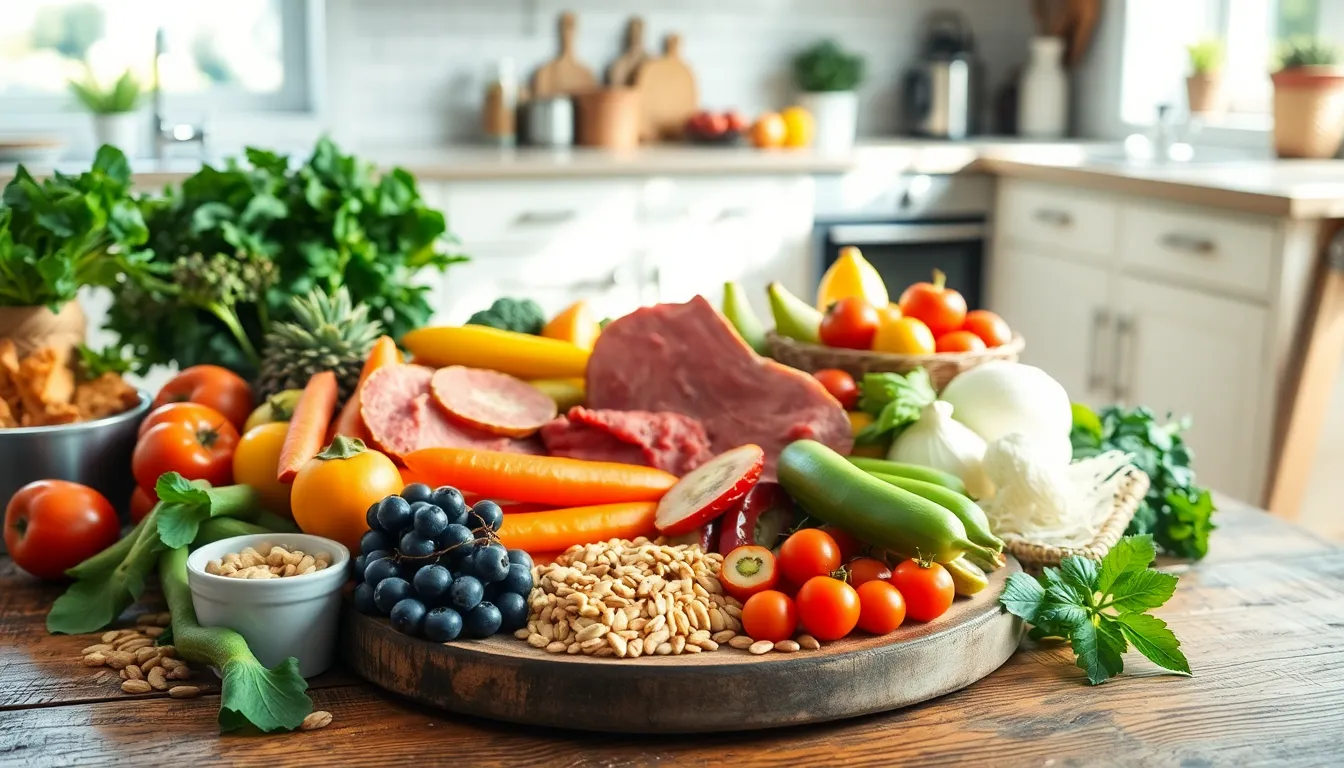Imagine munching on juicy steaks, fresh veggies, and ripe berries while saying goodbye to processed foods and counting carbs. Welcome to the Paleo diet plan, where cavemen would give a thumbs up and modern foodies rejoice. This eating style isn’t just about channeling your inner hunter-gatherer; it’s about embracing a lifestyle that prioritizes whole, nutrient-dense foods.
With its roots in ancient diets, the Paleo plan encourages participants to eat like our ancestors did—minus the woolly mammoths, of course. By focusing on what nature intended, many find it easier to shed unwanted pounds and boost their energy. Ready to dive into a world where delicious meets nutritious? Let’s explore how this diet can transform not just your plate, but your entire approach to health.
Table of Contents
ToggleOverview of the Paleo Diet Plan
The Paleo diet focuses on whole, nutrient-dense foods mirroring what early humans consumed. This approach aims to eliminate processed foods and refined sugars.
What Is the Paleo Diet?
The Paleo diet, often referred to as the caveman diet, emphasizes eating foods that resemble the diets of ancient ancestors. This lifestyle includes lean meats, fish, fruits, vegetables, nuts, and seeds. All processed items, dairy products, and grains are excluded from this regimen. Individuals following this diet seek to improve health by adopting the nutritional habits of past generations.
Key Principles of the Paleo Diet
The key principles of the Paleo diet revolve around whole food consumption and minimizing processed ingredients. Consuming high-quality proteins such as grass-fed beef and wild-caught fish forms the basis of meal choices. Fresh fruits and vegetables provide essential vitamins and minerals, contributing to overall health. Emphasizing healthy fats from sources like avocados and nuts helps promote satiety. The exclusion of grains, legumes, and processed sugars aims to reduce inflammation and support weight management. Adhering to these principles bolsters health and aligns dietary choices with natural eating patterns.
Benefits of the Paleo Diet Plan

The Paleo diet offers numerous advantages for those seeking a healthier lifestyle. It promotes eating whole foods that align with ancestral diets, which can lead to various health benefits.
Weight Loss and Management
Weight loss often occurs with the Paleo diet due to the elimination of processed foods, sugars, and grains. Reduced calorie intake from these lower nutritional value foods contributes to weight loss. Increased protein consumption in the diet can enhance satiety, resulting in fewer cravings and smaller portion sizes. Participants frequently report weight management ease, as this eating plan encourages whole foods that nourish the body. Improving metabolism through higher protein and fiber intake helps maintain a healthy weight.
Improved Nutritional Intake
Nutritional intake improves considerably on the Paleo diet. This plan emphasizes fresh fruits, vegetables, lean meats, fish, nuts, and seeds, all of which provide essential nutrients. Increased vitamins, minerals, and antioxidants support overall health and well-being. Balanced macronutrients, primarily from whole food sources, optimize energy levels throughout the day. Additionally, avoiding processed ingredients minimizes unhealthy fats and additives, contributing to better digestion and elimination. Overall, adopting the Paleo diet enhances dietary quality significantly.
Foods to Include in the Paleo Diet Plan
The Paleo diet plan focuses on wholesome, natural foods. Prioritizing certain categories enhances its benefits.
Lean Meats and Fish
Lean meats serve as primary protein sources. Grass-fed beef, pork, and lamb offer essential nutrients. Wild-caught fish provides heart-healthy omega-3 fatty acids. Skinless poultry delivers lean protein while being low in saturated fat. Meats and fish should come from high-quality, sustainable sources. Consuming these helps maintain muscle mass and supports metabolic health.
Fruits and Vegetables
Fruits and vegetables are crucial components of the Paleo diet. Fresh options, such as berries, apples, leafy greens, and cruciferous vegetables, offer vitamins and minerals. Choosing seasonal produce maximizes nutrient intake and flavor. Colorful fruits and vegetables contain antioxidants, promoting overall health. Including a variety helps with digestion and reduces inflammation. Aim for organic choices to minimize pesticide exposure and support local farming.
Foods to Avoid on the Paleo Diet Plan
The Paleo diet eliminates certain food groups that conflict with its principles. Understanding these exclusions is crucial for effective adherence to the diet.
Grains and Legumes
Grains and legumes stay off the Paleo diet list. Wheat, rice, corn, and oats contribute to inflammation and disrupt digestive health. Additionally, legumes such as beans and lentils contain antinutrients that can hinder nutrient absorption. Besides, these foods often contain gluten, which may cause adverse reactions in sensitive individuals. Prioritizing whole foods instead enhances nutrient density. Choosing alternatives like vegetables and nuts supports the diet’s goals.
Processed Foods and Sugars
Processed foods and sugars are major offenders on the Paleo diet. Items that contain additives, preservatives, or artificial ingredients fall under this category. Refined sugars, including cane sugar and high fructose corn syrup, cause spikes in blood sugar levels, leading to increased cravings. Foods such as snack bars and deli meats often contain hidden sugars and unhealthy fats. Cleaning up the diet builds a foundation of health. Focusing on whole foods, free from processing, promotes sustainable energy and overall well-being.
Tips for Following the Paleo Diet Plan
Adhering to the Paleo diet can be simple with the right strategies in place. Here are key tips to enhance the experience.
Meal Planning Strategies
Planning meals in advance streamlines grocery shopping and cooking. Focus on creating a weekly menu that includes lean proteins, vegetables, and fruits. Preparing large batches of compliant recipes saves time during the week. Utilizing containers to store pre-portioned meals can aid in quick access. Incorporating seasonal and organic produce enhances nutritional value and flavor. Staying organized ensures access to healthy, ready-to-eat options whenever hunger strikes.
Overcoming Common Challenges
Navigating challenges while following the Paleo diet demands proactive strategies. Social settings often present difficulties, but communicating dietary preferences to friends can foster understanding. Cravings for non-compliant foods arise, so seeking alternative snacks like nuts or fruits helps. Lack of variety can make the diet tedious, so exploring new recipes keeps meals exciting. Meal prepping reduces the likelihood of straying from the diet, making healthier choices more convenient. Engaging with online communities can provide support and inspiration when obstacles arise.
Embracing the Paleo diet can lead to significant improvements in health and well-being. By focusing on whole, nutrient-dense foods, individuals can experience enhanced energy levels and effective weight management. This approach not only supports a healthier lifestyle but also encourages mindfulness about food choices.
With practical tips for meal planning and strategies to overcome challenges, sticking to the Paleo diet becomes more attainable. Engaging with supportive communities and exploring diverse recipes can add excitement to the journey. As one adopts this caveman-inspired eating style, they may find themselves not just transforming their diet but also enriching their overall quality of life.





